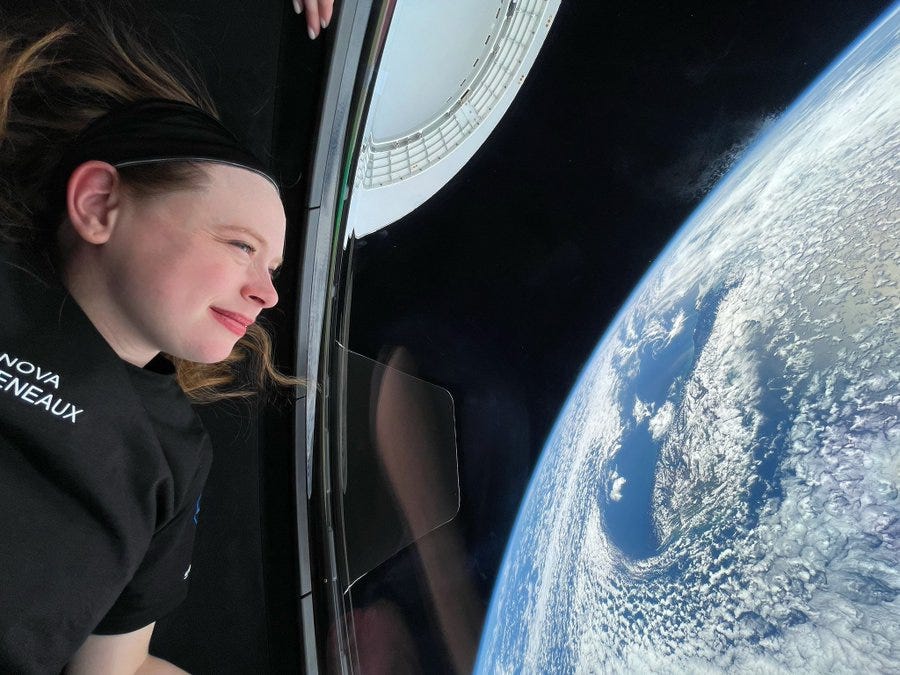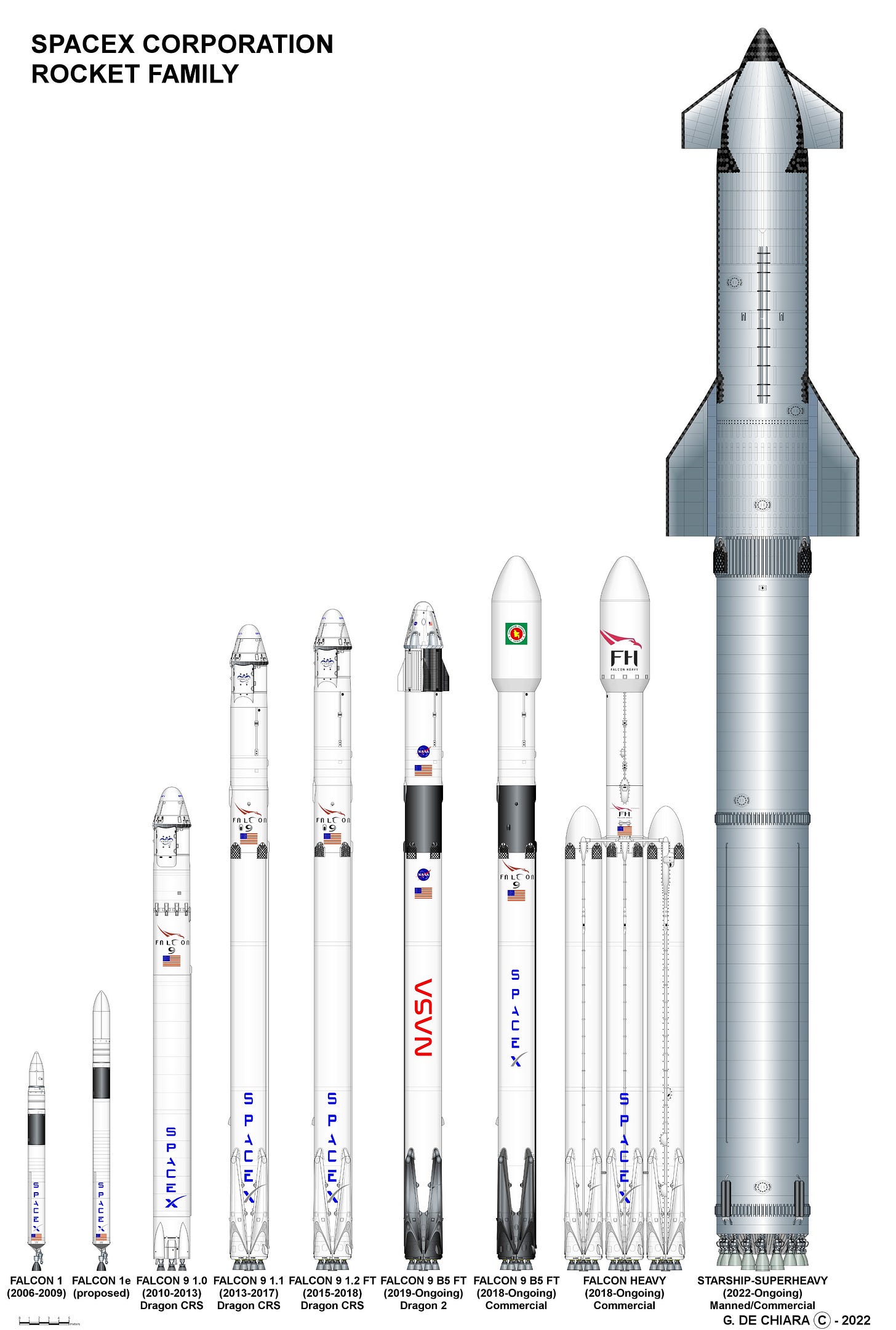“Don’t wanna jinx it, but SpaceX is tracking to lift 80% of all mass to orbit, China ~10% & rest of world ~10%” ~ Elon Musk
SpaceX are a private space company built to succeed and lately become so successful they have marginalized the competition. Arianespace, Mitsubishi and United Launch Alliance (ULA) have tied themselves in knots trying to compete, with no real answer to the reusable rockets fielded by SpaceX. However the incumbents price their expendable launch vehicles SpaceX can go lower, because they don’t need to build a new rocket for every launch (it’s estimated a reused Falcon 9 costs ~$15m to operate). Even small launch providers are feeling the heat following the introduction of Transporter and Bandwagon missions by SpaceX, which provide low cost launch to Low Earth Orbit (LEO) for groups of small satellites.
More importantly, Starship promises to carry up to 200 tons for a couple of million dollars, potentially absorbing the whole launch market like blotting paper. It’s questionable whether this is a healthy way to develop a sustainable space economy, because it will likely need strong commercial competition to be viable. However, it’s wise to tread carefully as we enter new realms and look more closely at the path they have set to follow.
Space Access
Humans have tried to expand into space since the nineteen sixties yet only recently has this become commercially viable, with SpaceX’s Axiom and Inspiration4 missions. Sending people to space is vital to the space economy because they will supply the means to operate effectively and a ready market for its services. AI has its place, alongside additive manufacturing, but only people possess the creative flexibility required to overcome all the novel challenges inherent to this new environment. Fortunately Starship could launch up to 1,000 people to LEO, assuming some orbital facility is ready to receive them or means available to send them further. This kind of scale is exactly what is needed to found a space economy, so SpaceX’s prowess in this area is essential to the overall success of the expansion effort.
Succinctly: Starship makes the space economy possible.
While cheap space access is an important first step, the dominance of a single launch company doesn’t restrict what is actually done in space, which could consist of a diverse market economy. Certainly SpaceX have taken care with how they wield their influence as the gatekeepers to space, taking a long term approach to nurture space development.
Space Bonsai
At first glance SpaceX appears fairly merciless with their launch competitors, flexing their technologic muscle to drive out potential rivals. On closer inspection, they have certainly made life difficult for traditional aerospace companies, while allowing sufficient breathing space for new growth. Legacy launch providers have effectively blockaded space by maintaining exploitative prices, and refused to perform the least development, except when amply compensated by government. Hence SpaceX are providing the stimulus for them to reform or failing that to disappear, effectively breaking the blockade. Fortunately, SpaceX have set launch prices at a level which can be met by more efficient companies, like Rocket Lab who roughly charge the same amount for smallsats as a Transporter mission. Overall this should encourage the development that is so vitally needed in the launch industry.

Moving downstream, SpaceX have done all they can to stimulate the space economy, even going so far as to support their potential rivals. Good example: SpaceX competes for the satellite broadband market with OneWeb, who were unable to complete their LEO constellation on Soyuz, until SpaceX offered to help launch their satellites on Falcon 9. Perhaps more pointedly, SpaceX have gone out of their way to support space access for people, first through NASA’s commercial Crew Program then with Axiom Space and Jared Isaacman’s Inspiration4 mission, which led to the far more ambitious Polaris Program. Instead of hogging the private astronaut market, SpaceX are actively encouraging people to break into it and support its longterm growth. For example, Jared Isaacman is a born entrepreneur, starting Shift4 Payments aged 16 then followed his passion to found Draken International, a pilot training company for armed forces. No doubt he plans to use Polaris as a springboard to create some space related company in the future, deepening his partnership with SpaceX and diversifying the space industry. Of course this burgeoning industry would require many new entrepreneurs, engineers and technicians to maintain momentum which could be a problem as SpaceX seems to absorb most of the top talent...
“Universum’s 2022 US rankings of the country’s top employers showed that SpaceX and Tesla were formally listed as the number one and number two most desired workplaces for engineering students. Both companies are also ranked among the top ten most attractive employers by computer science students.” ~ Teslarati
Space University
In practise SpaceX operates much like a space university, they take on ‘students’ (aka interns and young engineers) and provide all the practical experience necessary to turn them into space savants. To encourage them to complete the course, SpaceX personnel are offered company shares as a bonus, which vest after a couple of years. These vested shares encourage them to really apply themself (and receive more than a passing grade) because the harder they work the more the company succeeds, increasing the value of their shares. After three or four years these skilled professionals can cash-in these shares, providing sufficient capital to start-up their own company, likely related to the space industry given their prior experience. In this way SpaceX are continually churning out skilled personnel while creating potential commercial customers. The space economy needs novel space applications to succeed and, through its investment in people, SpaceX have created a fertile environment for these new companies to flourish and grow.
“SpaceX both incubates talent and inspires new companies to launch and grow… I would call them an anchor tenant in an innovation ecosystem.” ~ Krisztina Holly, founder of Make it in LA
Space Culture
By now we can see SpaceX doesn’t operate like a normal company that fixates on quarterly profit and growth. In practise they take the long view of supporting space development, and reinvest all their profits into new hardware systems and people. This uncommonly altruistic approach is essential given the company’s increasing influence and their long term plans for space expansion. SpaceX aim to create new space cultures, free from external control, completely open to commerce. For example they aim to make Mars self-sustaining and fully independent by the year 2050, allowing it to eventually exceed the cultural and technologic development of Earth. Here’s a quote from the Governing Law section of their Starlink contract, which clearly outlines their intent: -
“For [Starlink] Services provided on Mars, or in transit to Mars via Starship or other colonization spacecraft, the parties recognize Mars as a free planet and that no Earth-based government has authority or sovereignty over Martian activities. Accordingly, Disputes will be settled through self-governing principles, established in good faith, at the time of Martian settlement.” ~ Starlink Reddit
SpaceX also suggest direct democracy should be used for governance of the colony, although this is probably just the starting place for the culture that will eventually evolve in this alien setting. Essentially, whether people choose to compete or cooperate on these new worlds (and how) will be left to their discretion, to suit their own situation, rather than dictated from afar by Earth.
In conclusion
Instead of exploiting its monopoly on commercial launch, SpaceX have evolved a more practical approach to space development, effectively clearing away dead wood to encourage new growth. Their ever increasing income has allowed them to undertake inordinately ambitious projects like Starship and Starlink, designed to stimulate and accelerate an emerging space economy.
They say: “with great power comes great responsibility,” something SpaceX seem willing to shoulder given their strategy to support anyone involved in space expansion. Yes, they are extremely successful but seem committed to taking us higher and the antidote to legacy launch lethargy.





I wasn’t aware that they were handing out shares. Very interesting. It makes me wonder if a Triple Helix Innovation Model could be perfected with some blend of government subsidies, university R&D, and corporate guidance: https://www.lianeon.org/p/the-triple-helix-of-innovation
As to your article, what surprises me most about SpaceX is that they are just as far ahead of the competition as they were a decade ago; the competition gained no ground.
SpaceX first achievement was a ~50 percent cost reduction by building and designing rockets efficiently, they did this around 2012. Only now are the ULA, Arianespace approaching this.
SpaceX’s second achievement (2017) was another ~50 percent cut in costs, achieved by partial reuse. It’s hard to imagine Mitsubishi, Arianespace, ULA getting there before 2030. RocketLab and Blue Origin might, and China’s CAST might.
The problem is that SpaceX is already moving on toward a 3rd breakthrough: full and rapid reuse, which could easily cut launch costs another 50 percent or more.
I consider "Starship promises to carry up to 200 tons for a couple of million dollars, potentially absorbing the whole launch market like blotting paper" to be unlikely. More like 150 T to LEO for $50M for outside customers, simply undercutting the F9 a bit, and probably less than RL for Neutron. There is no reason for SpaceX to give away profit, although I can see them cutting the price for joint ventures. Beyond that, although we can maybe project another 10% cost savings for F9/FH, the real operational cost of Starship will take years to realize. Maybe then we can compare Starship to Relativity, Firefly, RL, Stoke in the 2025 time frame. Also, 150T to a single inclination is great for mega-constellations, but there a number of missions that are not optimized for 150T at a time.
I agree that SpaceX is a different company from a hiring perspective, expecting some serious work hours in exchange for a one of kind experiment that maybe in 20 years you will be telling you kids about how you supported humans on Mars. My hope this that these experiences, stock options and networks will continue to create a space eco-system that SpaceX has not claimed yet.
Per competition, without China, then only in the small sat launch biz that RL has a price leading offering if you need to go somewhere else than (SSO, an Starlink orbit or a Bandwagon Orbit). Note that even with the US gov't doing what they can to help them out, this is a 10 a year market.